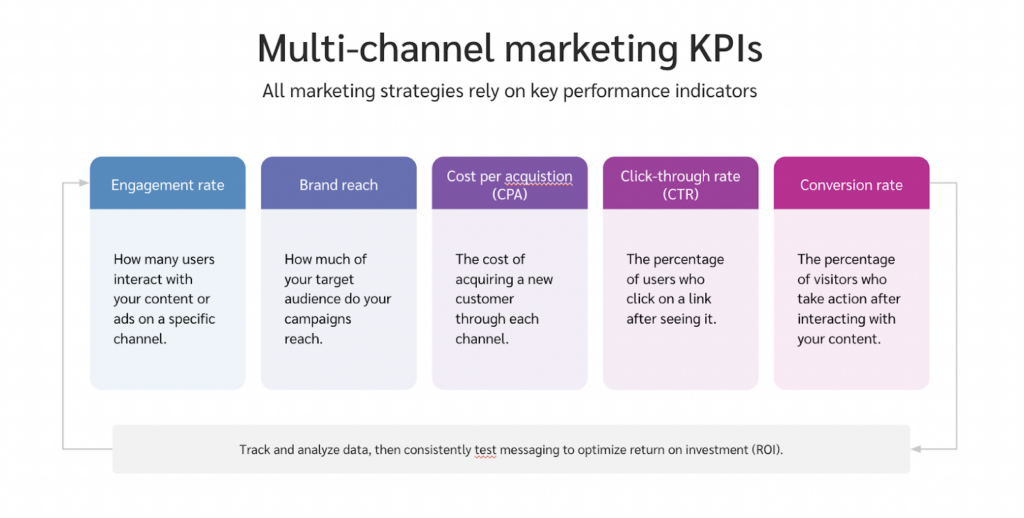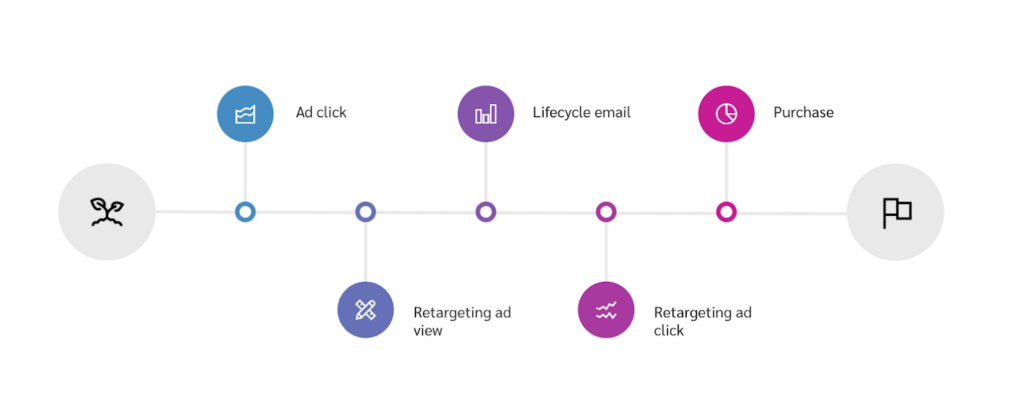Content
- What is Multi-Channel Marketing?
- How to use Multi-Channel Marketing Effectively?
- How to Build a Successful Multi-Channel Marketing Strategy
- The challenges of multi-channel marketing
- Leverage a multi-channel marketing platform
- FAQ: Multi-channel marketing
What is Multi-Channel Marketing?
Multi-channel marketing involves using two or more channels to promote products and services to customers. A multi-channel approach recognizes that customers may prefer interacting with different marketing channels. It lets customers choose to interact with the mediums they’re most comfortable with.
By using multiple channels, marketers can target a wider audience and increase the probability of reaching customers in the most convenient way for them.
Customers usually interact with multiple touchpoints before converting––they may discover, research, and finally purchase on different mediums. For example, they may find out about your brand via an influencer’s LinkedIn post, search your company blog to understand product features and check their email for a promotional code.
You might choose to include these digital and offline marketing channels in your multi-channel campaigns:
- Websites (including blogs)
- Social media
- PPC (pay-per-click) advertising, including Google Ads
- Mobile marketing (apps and SMS)
- Email marketing
- Offline channels like retail stores
How to use multi-channel marketing effectively
Multi-channel marketing aims to reach customers where they are and share consistent messaging across all channels.
Here are a few tips on how to use multi-channel marketing effectively:
- Get to know your target audience. Understand your target audience’s preferences, habits, and communication style to identify the most effective channels.
- Choose the right channels. Choose the channels that will work best for your business based on your target audience. For example, if your target audience is older, they may be more active on Facebook than TikTok.
- Communicate consistently. Ensure your messaging is consistent across all channels to encourage brand recognition and trust.
- Analyze data. Lean into campaign data to measure the effectiveness of each channel and make changes as needed.
How to build a successful multi-channel marketing strategy
A successful multi-channel marketing strategy involves deeply understanding your target audience and the channels they’re most likely to use to interact with your business.
1. Define your buyer personas
Before creating your strategy, you need to define your buyer personas clearly. This includes researching their demographics, behaviors, interests, and buying habits. It also means analyzing how your product or service can solve their pain points.
2. Identify the channels you want to target
Multi-channel marketing doesn’t mean you need to target every channel. Focus on those channels that will resonate best with your audience. Consider where your target audience spends their time.
Are they active on LinkedIn? Or are they more likely to engage with your brand at an in-person event?
Targeting the channels most likely to work best for your business will ensure you maximize your resources and get in front of target customers most likely to buy.
3. Identify the channels you want to target
The most successful marketing efforts on and offline don’t exist in a vacuum––instead, they complement one another. A multi-channel approach needs to exist as cross-channel marketing too.
This is when you coordinate campaigns across multiple channels to create a consistent experience for the customer. Whether your audience interacts with your company blog, Facebook ad campaign, or newsletter, the tone of your messaging needs to remain consistent.
Your marketing efforts need to be cohesive across each channel. When customers switch from one platform to another, they instantly need to know they’re interacting with the same brand.
4. Determine your key performance indicators (KPIs)
Track and analyze data to measure the effectiveness of each channel and make changes accordingly. Consistently test and optimize your messaging to maximize your ROI.

Companies define the success of their marketing campaigns differently. Here are some KPIs you may consider measuring:
- Engagement rate. How many users interact with your content or ads on a specific channel.
- Brand reach. How much of your target audience do your campaigns reach.
- Cost per acquisition (CPA). The cost of acquiring a new customer through each channel.
- Click-through rate (CTR). The percentage of users who click on a link after seeing it. Analyze CTR across all channels to identify the channels generating the most engagement.
- Conversion rate. The percentage of visitors who take action after interacting with your content. This could be starting a free trial, subscribing to a newsletter, or purchasing.
The challenges of multi-channel marketing
While giving your customers a choice is good, multi-channel marketing can be a challenge for marketers to get right. It requires careful planning, organization, and execution to overcome obstacles and succeed.
Efficient management
Maintaining consistency across each can be taxing with so many different channels and limited time. This is especially true when each channel comes with its own set of unique requirements and limitations.
Effective multi-channel marketing means implementing integrated marketing and handling cross-promotions so that different channels work together. This isn’t always easy to set up.
Since there are more elements to manage with multi-channel marketing, you may need to allocate more resources, like a larger budget or hire more team members.
Proper marketing attribution
You should identify top-performing marketing channels and clearly understand the customer journey. The more marketing channels you add, the more complex it is to attribute conversions correctly.
It’s easy to misattribute conversions and believe one marketing channel is more effective in driving conversions than another. Accurately attributing conversions to these campaigns is tricky if you rely on offline marketing mediums.
Leveraging marketing analytics
Accurately measuring the success of multi-channel marketing can take a lot of work to get right. Gathering, analyzing, and managing data from various channels is time-consuming and complex. This is especially true when each channel relies on its own set of data points, metrics, and tools.
Leverage a multi-channel marketing platform
Integrate the experience across channels
The channels you use for your campaigns need to work together––they can’t exist as silos. It’s not enough to set up a newsletter, Instagram account, and blog if they don’t somehow connect up. One customer will move between all these channels, so your analytics and strategy need to link together.
Using a Partnership Management Platform can streamline your marketing partnership operations and make it easier to create a unified experience.
Implement marketing automation
Marketing automation can help you personalize your marketing efforts to individual customers. Create a marketing automation system where email opens, CTA clicks, pages visited, and engagement are recorded in one place.
Then use this customer data for retargeting potential customers with personalized ads and emails.
Plan how you’ll measure attribution
Most customers engage with businesses through multiple channels before converting. Few customers purchase on their first interaction with your business.

Your attribution technique should reflect reliance on multiple channels for campaigns. By using multi-channel attribution, you can identify which marketing channels result in more conversions. When set up properly, you can also attribute specific purchases to their respective touchpoints.
Key takeaway: Use multi-channel marketing to reach your target audience where they are
Multi-channel marketing sounds labor-intensive and complex to manage. But when you plan a multi-channel marketing strategy effectively, it’s much easier to interact with your audience and offer a cohesive experience. This, in turn, results in higher customer satisfaction and a greater conversion rate.
Want to learn about driving revenue through content partnerships? Learn about how commerce content increases revenue.
Check out these additional reading materials:
- Working with YouTube influencers [6 pro tips for success]
- TikTok and commerce: 4 reasons why brands succeed with “shoptainment”
- Content amplification strategy for publishers: how to set up your commerce content for success
FAQ: Multi-channel marketing
Multi-channel and omnichannel are marketing strategies involve using different channels to promote products and services to customers. Multi-channel marketing means using several channels to reach a target audience. For instance, a brand might have a blog, Facebook page, and physical store, but each channel operates separately with its own messaging.
Omnichannel marketing means building a coherent customer experience across all channels. For example, customers might start browsing sneakers online, add a pair to their cart, and receive an email reminder about the shoes.
Some of the key benefits of multi-channel marketing include:
– Increased brand awareness. You’ll reach a larger audience and boost brand awareness by using more channels to promote your business.
– Higher conversion rates. Since you’re providing customers with more options to interact with your business, you’ll boost the chance they’ll purchase.
– Stronger targeting. Different channels appeal to different demographics and target audiences. You can reach a broader audience and optimize your messaging to more targeted groups by using multiple channels.
– Better customer experience. When you offer multiple ways for customers to interact with your business, you make it easier for them to find what they’re looking for and purchase.
Let’s say a company wants to promote a new project management tool. They might start by creating Facebook ads with information about the product and a call-to-action (CTA) button to encourage visitors to sign up for a free trial.
They may email their existing email list with a promo code for the first subscribers. The brand might also create blog posts explaining the tool’s different features and run targeted ads on Google to direct people to their site.
Finally, they might create physical flyers to share at an in-person conference. Through this approach, the company can reach a larger target audience and boost the chance of conversions.
Expand your knowledge of partnership marketing with these informative impact.com resources:




